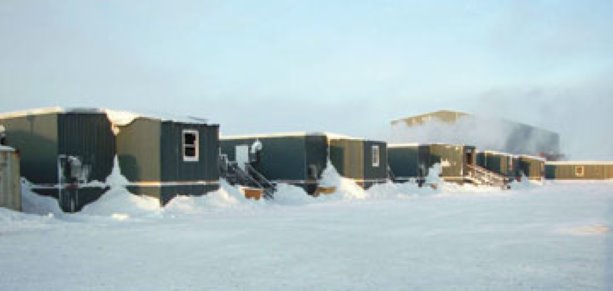With its head office safely tucked away in Brampton, Ont., Outland Camps has helped establish construction camps in some of Canada’s most remote northerly locations with encampments ranging from eight-person tent camps, to 500-person permanent mobile trailers — some complete with squash courts and gyms.
With its head office safely tucked away in Brampton, Ont., Outland Camps has helped establish construction camps in some of Canada’s most remote northerly locations with encampments ranging from eight-person tent camps, to 500-person permanent mobile trailers — some complete with squash courts and gyms.
The company started life 22 years ago supplying camps for its own forestry and fire fighting operations, but expanded into resource industry, mining and exploration camps stretching far north into extreme Arctic climates.
The company builds, rents or operates camps on behalf of clients with camps ranging from the coast of B.C. to Labrador and north to Nunavut.
The term “construction camp” is a bit of a misnomer, notes Jeff Taylor, responsible for the company’s Western Canada, Ontario & The Arctic division.
“Most of our work begins as an exploration camp, then evolves into a construction camp and finally becomes whatever type of camp you need as a more permanent establishment,” he says.
“The way we plan is to try to bring enough material to start with what you want to end up with — which is not always easy. You start with a completely blank palette, and you can think about a project like it’s on the moon. As it gets bigger, you add more infrastructure.”
Camps usually begin with an exploration team that arrives by air, either by helicopter or airplane. Once the parameters of the camp have been established, supply routes are mapped out to bring in construction material.
When winter roads, all season roads, or dirt roads are established, the camp is assembled from modular units brought in by barge from boats, or overland by tractor trailer. The company provides site design services and supplies skilled tradespeople to install and set up the camps.
Outland has forged partnerships with Inuit and First Nations communities, relying on local suppliers to provide logistical support for the camps.
“Typically, we lay down a flat gravel area as a base for the camp buildings,” says Taylor. “We just did one in Nunavut where we blasted and crushed gravel that was removed when we built the access road.”
What goes up next is entirely up to the client — within logistical reason. Housing usually consists of modular structures assembled in trailer camp style.
Construction camps usually house far more people than permanent camps, so the construction phase of a remote camp is much larger than the final configuration. The additional personnel are often housed in temporary tents and structures.
The company’s most northern camp is the Agnico Eagle Camp located in Baker Lake, designed to support up to 700 construction personnel on a temporary basis, and eventually housing 350 permanent personnel involved in gold mining.
Taylor says that clients have become much more demanding in what they request as camp amenities.
“In addition to the infrastructure we have to bring, such as water treatment and sewage treatment systems and waste oil burners, they might also want a satellite dish for Internet and cell phone service, squash courts, and a gym,” he says.
“We can deliver a squash court in two pieces that fit together to form a proper court. Decades ago you might have four men to a room until two-person units became the norm. Now we have both men and women in camps and everyone has their own bedroom and washroom.”
The company also provides catering services for camp personnel. There’s really no difference in meal preference between people on one side of the country or the other, says Taylor. “It runs more along an age line, with the younger guys tending toward leaner meats, fruit and vegetables, while the old-timers are more heavy on the gravy and deep-fried stuff. When you’re the only kitchen in town you have to offer lots of choices, buffet style.”
Taylor says that safety in remote camps is the number one priority.
“Even if medical help is readily available in camp, weather plays a huge part in camp life.
“Three years ago, I was stuck in a blizzard in the Arctic for 14 days at -50C with winds blowing at 90 kilometres per hour. It was so cold that all of the systems were shutting down and engines wouldn’t start. We had to bring in oil drums from the tank farm by sled to heat the tents.
“If someone had been hurt, there would have been no way to get out. When you’re out there with 30 or 40 people, you watch out for each other and stick together.”











Recent Comments
comments for this post are closed